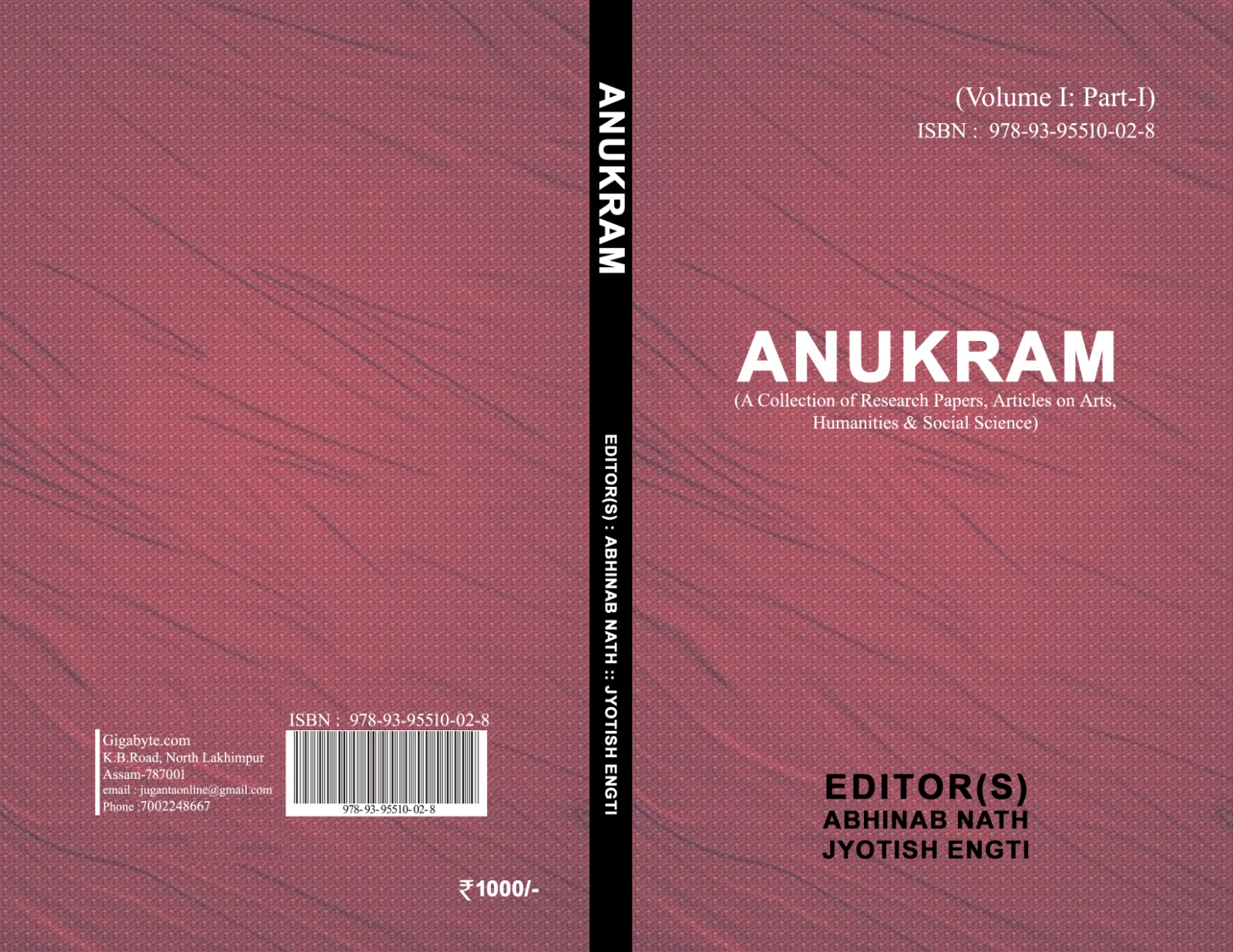Department of Economics
Department of Economics of the College established in 1984. The teaching community of the department has been extending their expertise in the development of the local economy over the years. The department has been rendering its services mainly in teaching, research activities and curricular activities of the student. The Department has got 04 numbers of sanctioned faculty posts with student-teacher ratio of 12.5:1.
ASSISTANT PROFESSOR

EX- FACULTY
PURANANANDA SAIKIA (1984- 1985)
BIRENDRA KR SAIKIA (1985- 2018)
MRS RUMI DUTTA (1989)
MRS SAHIDA BEGUM (1988- 2019)
ASSISTANT PROFESSOR

ASSISTANT PROFESSOR

ASSISTANT PROFESSOR


COURSE OUT COME
DEPARTMENT OF ECONOMICS
PANIGAON OPD COLLEGE
B A ECONOMICS-CORE COURSE-(C-1)
|
Course |
Unit |
Course Outcome |
|
Course1- Introductory
of Microeconomics |
CO1:subject Matter of Economics |
Basic
concept of micro-economics . |
|
CO2: Supply and Demand analysis |
Basic concept of demand, supply and
consumer and producer surplus |
|
|
CO3Household and consumer Choice |
Able to analysis consumer, producer
behavior and decisions .. |
|
|
CO4: the firm and perfect market |
Basic concepts of cost, revenue and
government policies towards competition. |
|
|
CO1:input market. |
: Basic
concept of input market.. |
|
|
Program Outcome:-After the completion of this
Course, the student will be able to attain the basic concept In economics and
apply economic principle in real life.
|
||
|
CORE
COURSE-(C-2) |
||
|
Mathematical
Method for Economics |
CO1:Preliminaries |
Preliminary
concept of mathematics such as set operation, function and relation. |
|
CO2: Function of one real
variable. |
Concept of Function
and limit and its various operation and application in
economics |
|
|
CO3:Derivative for function of
one variable. |
Knowledge of
differential calculus and its application in the different fields of
economics |
|
|
CO4:Intergration of function |
Knowledge of
integral calculus and its application in the different fields of economics. |
|
|
CO5: Differential Equation |
Concept of
first order linear differential equation with constant coefficient and its
application in the economic field |
|
|
Program Outcome:-After completion of the
course students are able to learn how mathematical tools and technique are
used in economics and Study to analysis and interpret economic policies in
the light of mathematical tool of analysis. And
also understand the basic mathematics that enables the study of economics
theory especially on microeconomics
theory, macroeconomics theory, statistics and econometrics set. .
|
||
CORE
COURSE-(C-3)
|
Course3- INTRODUCTORY MACRO
ECONOMIC:- |
CO1:Introduction of macroeconomics |
Concepts
regarding formation of national income. |
|
||
|
CO2:Measurement of GDP |
Able to analysis the national income
accounting and to measure of National Income |
|
|||
|
CO3:Demand and supply of money. |
Concepts of money and
determination of value of money |
|
|||
|
CO4:Inflation |
Inflation and its impact on economy. |
|
|||
|
|
CO5:Theory of determination of
Income and employment |
Different
theory regarding determination of income and employment |
|
||
|
Program
Output:-After the completion of Course, the student will be able to attain
the preliminary concept of
macro-economic associated with the determination and measurement of aggregate
macro-economic variables. |
|
||||
|
CORE
COURSE-(C-4) |
|
||||
|
Mathematical methods for
Economics-II
|
CO1:Differential equation. |
Analysis
first order differential equation its operation and application in economics |
|
||
|
CO2:Liner Algebra |
Concepts of
matrix and determinate and its
operation and application in economics |
|
|||
|
CO3: Derivatives of Function. |
How
derivative help to analysis production function |
|
|||
|
CO4:Unconstrained Optimization. |
concepts of
maximization and minimization and its operation in market analysis |
|
|||
|
CO5:Unconstrained Optimization |
Analysis of
constrained optimization and its application in consumer and producer surplus |
|
|||
|
Able to
learn how basic mathematical tools and technique are used in economic theory
specially in micro, macro economic theory, statistics and economatrics and
Study to analysis and interpret economic policies in the light of
mathematical tool. |
|
||||
|
CORE
COURSE-(C-5) |
|
||||
|
Course-5- Essentials of
Microeconomics |
CO1:Consumer Theory-I |
Understand utility maximisation with given
budget constraints and minimization of cost. |
|
||
|
CO2: Consumer Theory-II |
In this chapter concepts are concern changes
in the market and how they impact consumption patterns for consumer goods and
services. |
|
|||
|
CO3: Production Theory |
Know the technological relationship between
input and output, expansion path and returns to scale of a firm/ industry. |
|
|||
|
CO4: Cost Function |
Know the different types of cost in
production process. Economics and diseconomies of large scale production. |
|
|||
|
CO5:Perfect Competition |
Nature and behavior of firm under competitive
market and maximization of profit in competitive market. |
|
|||
|
Program outcome:-After completion of the
course students are able to learned the behavior of consumer and producer and
also behavior of market |
|
||||
|
CORE
COURSE-(C-6) |
|
||||
|
Course-6- Essentials of
Macroeconomics |
unit:1Consumption function |
Analyses Short run and long run consumption
functions, different theories related to consumption |
|
||
|
unit:2Investment function |
Different
concept of investment. Marginal efficiency of capital, multiplier effect of
investment |
|
|||
|
unit:3Inflation and unemployment |
Know the relationship between inflation and
unemployment, expectations and policy ineffectiveness |
|
|||
|
unit:4 Macroeconomics of an open
economy- I |
Mundell- Fleming model in case of open and
close economy,purchasing power parity theory |
|
|||
|
unit:5 Macroeconomics of an open
economy- II |
Understand equilibrium
and disequilibrium of balance of payments, adjustment of balance of payments
and factor causing balance of payments disequilibrium. |
|
|||
|
Program Outcome:-Essentials of Macroeconomics
After the completion of this course, it is believed that learners would
understand the formal modelling of a macro-economy in terms of analytical
tools. They will also understand the various alternative theories of output
and employment determination in a closed economy in the short run as well as
medium run, and the role of policy in this context. It would also introduce
them to various theoretical issues related to an open economy |
|
||||
|
CORE
COURSE-(C-7) |
|
||||
|
Statistical Method for Economics |
CO1: Descriptive statistics |
Help to know the basic concept and
terminology that are fundamental to statistical analysis and inference. |
|
||
|
unit:2 |
Concept to understand the notion of
probability, followed by probability distribution and mathematical
expectation. |
|
|||
|
unit:3 |
Concept to understand Random and mathematical
expectation. And also binomial distribution. |
|
|||
|
unit:4 |
Helps used to collection of survey data and sampling technique in economics. |
|
|||
|
|
unit:5 |
Concept and
mathematical technique of correlation and regression |
|
||
|
Program Outcome:- After the completion of
this course, learners will be in a position to understand the use of
statistical tools and reasoning in
economics and in the field of research.. |
|
||||
|
CORE
COURSE-(C-8) |
|
||||
|
Advanced Microeconomics |
unit:1 |
How supply and
demand interact and tend toward a balance in an economy of multiple markets
working at once and helps in predicting the
consequences of an autonomous economic event. |
|
||
|
unit:2 |
Price and output
determination, profit maximizing under
price discrimination. |
|
|||
|
unit:3 |
Price and output determination under
oligopoly market. |
|
|||
|
|
unit:4 |
Importance and application of game theory in
economics. |
|
||
|
|
unit:5 |
Externalities and solution of externality
problem. |
|
||
|
Program Outcome.-Develop the ability to
explain core economic terms, concepts, and theories. Explain the function of market and prices as allocative mechanisms.
Apply the concept of equilibrium to both microeconomics and macroeconomics.
Identify key macroeconomic indicators and measures of economics change,
growth, and development. |
|
||||
|
CORE
COURSE-(C-9) |
|
||||
|
Advanced Microeconomics |
unit:1 |
Student will able to know
the consumption function, in economics, the relationship between consumer spending
and the various factors determining it. At the household or family level,
these factors may include income,
wealth, expectations about the level and riskiness of future income or
wealth, interest rates, age, education, and family size. |
|
||
|
unit:2 |
Concept of economic
model and its benefit to economic growth in higher
living and ,balanced-growth
equilibrium. |
|
|||
|
unit:3 |
Technology
progress and policies to promote economic growth. |
|
|||
|
unit:4 |
Fiscal and monetary policy for economic
growth. |
|
|||
|
unit:5 |
Economist view to changes in economic output,
inflation, interest and foreign exchange rates, and the balance of payments. Poverty reduction, social equity, and sustainable
growth are only possible with sound monetary and fiscal policies. |
|
|||
|
Program Outcome:-After completion of this paper,It is hoped that the learners
would be in a position to understand the long run dynamic issues like growth
and technical progress. They will also understand the micro-foundations to the
various aggregative concepts used in the previous course |
|
||||
|
CORE
COURSE-(C-10) |
|
||||
|
Introductory Econometrics |
unit:1 Nature and scope of econometrics |
Analyses Concept of econometrics,
econometrics model and methodology, estimate and estimator, probability
distribution, hypothesis testing |
|
||
|
unit:2 simple linear regression model |
Concepts of linearity and non linearity, CLRM,
BLUE, Gauss Markov theorem |
|
|||
|
unit:3Violations of classical assumption |
Problems, consequences, test and detection of
heteosecedasticity and autocorrelation |
|
|||
|
unit:4Multicollinearity |
Problems, sources, consequences, detection
and remedies of multicollinearity. |
|
|||
|
unit:5 Specification Analysis |
Omission of relevant variable and inclusion
of irrelevant vriables |
|
|||
|
Program Outcome:-Introductory Econometrics
basic econometric concepts and techniques along with statistical concepts of
hypothesis testing, estimation and diagnostic checking of simple and multiple
regression models. They will also understand the consequences of and tests
for misspecification of regression models. |
|
||||
|
CORE
COURSE-(C-11) |
|
||||
|
Indian Economy-I |
unit:1 |
Economic problems and trends of economic
development of India since independence. |
|
||
|
unit:2 |
Demographic change and human development in global prospect. |
|
|||
|
unit:3 |
Poverty and unemployment problems in india
and its alleviation measures |
|
|||
|
unit:4 |
Comparisons of Indian economy with
international economy. |
|
|||
|
Program
Outcome:-It is hoped that the learners after completing this course, would be
sensitized to the major trends in economic indicators in India in the post
Independence period with particular emphasis on paradigm shifts and turning
points and Understand
the importance, causes and impact of population growth and its distribution,
translate and relate them with economic development
|
|
||||
|
CORE COURSE-(C-12) |
|
|
|
||
|
Development Economics |
unit:1concept of development |
Characteristics
of underdeveloped economies, concepts of GNP, PQLI, HDI, GDI, GEM.
|
|
||
|
unit:2strategies of development |
Analyses Rostow stages of Economic growth,
Low level equilibrium trap, Big push theory, Balanced vs. Unbalanced growth |
|
|||
|
unit:3growth models |
Understand Harrod-Domar model;
Kaldor‘s Model, Solow Endogenous growth model. |
|
|||
|
unit:4poverty and inequality |
Concept and Measures of poverty- HPI, MPI.
Gini Coefficent and Lorenz Curve; Connections between inequality and
development. |
|
|||
|
unit:5Political institutions and functioning of the state |
Analyze relationship between democracy and
economic development, State ownership and regulation; Government failures and
Corruption |
|
|||
|
Program Outcome:- After completing this
course learners able understand different measures of economic development
and growth of a region . |
|
||||
|
CORE
COURSE-(C-13) |
|
||||
|
Indian Economy-II |
unit:1 Macroeconomic Policies and Their Impact
|
Understand Fiscal reform measures in the
context of India, Black money and Parallel economy in India, Export Import
Policy, Foreign Trade Policy. |
|
||
|
unit:2 Policies and Performance in Agriculture
|
Growth and productivity of Agriculture,
concept of Sustainable agriculture, Green revolution ,land reforms, rural
credit, agricultural marketing. |
|
|||
|
unit:3 Policies and Performance in Industry
|
Analyze Industrial growth and productivity in
the post reform period, Public Sector reforms, Disinvestment and
Privatization, MSME Sector, Foreign Investment in the Industrial sector. |
|
|||
|
unit:4 Trends and Performance in Services
|
Role Growth in and composition of service
sector in the Indian Economy, the service sector, Balance of payments
position, Trade in services and WTO. |
|
|||
|
|||||
|
Program Outcome:- |
|
||||
|
CORE
COURSE-(C-14) |
|
||||
|
Development Economics-II |
unit:1 Demography and Development
|
Concept of birth and death rates, age structure,
fertility and mortality, relationship between Population growth and economic development, concept of
Migration. |
|
||
|
|
unit:2 Land, Labor and Credit Markets
|
Analyze
the distribution of land ownership, land reform and its effects on
productivity, nutrition and labor productivity, microfinance.
|
|
||
|
|
unit:3 Communities and Economic Development
|
Management of Common Property Resources and Overcoming
the community failure
|
|
||
|
|
unit:4 Environment and Sustainable Development
|
Concept and indicators of sustainable
development ,Environmental externalities and state regulation of the
environment, Economic activity and climate change |
|
||
|
|
unit:5 Trade, Globalization and Development
|
Analyze international Trade, Role of Foreign
Capital and Foreign Aid in Economic Development. |
|
||
|
Program Outcome:- |
|
||||
|
DSE-1 |
|
|
|
||
|
Money and Financial Market |
unit:1 Money
|
Concept,
functions, measurement of money, theories of money supply determination, High
powered money and money multiplier. |
|
||
|
|
unit:2 Financial Institutions, Markets, Instruments
and Financial Innovations
|
Role of financial markets , concept of
Treasury bill market, Commercial bill ,Financial sector Reforms in India,
Role of Financial Derivatives , Banking and Non Banking Financial
Institutions
|
|
||
|
|
unit:3 Stock Market |
Analyze
Stock Market and its Operations, Stock Market Index, BSE Sensex, NSE
Nifty.
|
|
||
|
|
unit:4 Public Revenue
|
Tax and
Non tax revenue, The Ability to Pay Principle and the Benefit Principle of
taxation, Incidence of taxation- Neutrality, Efficiency and Equity in
taxation, Optimal taxation |
|
||
|
|
unit:5 Corporate Finance
|
Main
features of India‘s Tax System
|
|
||
|
Program Outcome:-After completion of the
program students are able to understand area of finance, accounting, and
investment in stock market. Also they know about the different surceases of
tax and non tax revenue. |
|
||||
|
DSE-2 |
|
||||
|
Public Economics |
Co1: Fiscal
Function |
Need of public sector and stabilization of
government co-ordination and conflict of function |
|
||
|
CO2:Public Goods |
Concept of public goods, efficiency
allocation of public goods and public expenditure |
|
|||
|
CO3: Externalities |
Concept of externalities, market failure and
assignment of property right. |
|
|||
|
CO4: Public Revenue |
Meaning, importance and distribution of tax. |
|
|||
|
CO5:Indian Public Finance |
Indian tax system, structure and reforms
since 1991 |
|
|||
|
Program Outcome:- After completion of this course the student will learn the
government policy from the point of view of economic efficiency and equity.
They will understand the nature of government intervention and its
implications for allocation, distribution and stabilization along with
government taxation and expenditure. Besides, they will also learn about
the topics such as public goods,
market failures and externalities |
|
||||
|
DSE-3 |
|
|
|
||
|
Environmental Economics |
CO1:Introduction |
Basic Concept of Environment and its relation
to Economics activities |
|
||
|
|
CO2:Theory of Externalities |
Meaning of externalities and market failure
in presence of externalities and its solution. |
|
||
|
|
CO3:Environmental Policy and sustainable Development |
Economic Policy to solution of environmental
degradation and sustainable development. |
|
||
|
|
ICO4:nternational Environmental Problems |
Problems of international externalities and
global intervention for sustainable development. |
|
||
|
|
CO5:Measuring the benefits of Environmental Improvement |
Value of environmental improvement |
|
||
|
Program Outcome:- Environmental Economics By
the end of this course, the learners will be in a position to understand
economic causes of environmental problems. They will understand how economic
principles are applied to environmental questions and their management
through various economic institutions, economic incentives and other
instruments and policies. They will also understand the economic implications
of environmental policy as well as valuation of environmental quality,
quantification of environmental damages, tools for evaluation of
environmental projects such as cost-benefit analysis and environmental impact
assessments |
|
||||
|
DSE-4 |
|
|
|
||
|
The Economy of North East |
unit:1Economic Characteristics of North East India
|
Know about
Mineral, Forest and Water resources, Human resources of NE India,
Composition,Distribution density of the population, Migration of population,
Urbanisation, Occupational distribution.
|
|
||
|
|
unit:2 Agriculture
|
Analyze Land use, Agricultural holdings and
Cropping pattern, Horticulture, Sericulture, Jhum Cultivation, Modernisation
and Sustainable agriculture.
|
|
||
|
|
unit:3Industry
|
Know
about the Problems and prospects of Industrial development of NE region, Role
of Tea, Oil and Coal industries, Micro, small and medium industries, Tourism.
|
|
||
|
|
unit:4Infrastructure
|
Understand
Economic Infrastructure and Social Infrastructures of the region ,The Role of
North Eastern Council.
|
|
||
|
|
unit:5 Developmental issues of the Region
|
Analyse
Poverty and Unemploymentof the region, Problems of Agricultural labourers .
|
|
||
|
|||||
Programe
outcome: This paper will give a general outline of the economy of north east
India. On completion of this paper, students will be able to know about the
resources and infrastructure facility of that region. They also know the
potentiality of agriculture and industry sector of N-E India.
